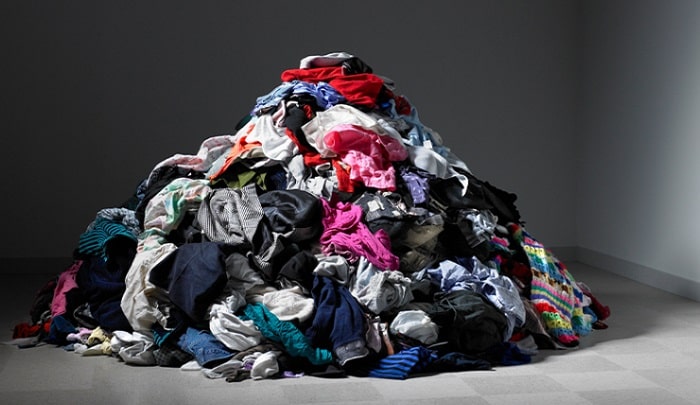The textile industry is known for its rapid production and consumption cycle, which has led to significant waste generation. Currently, the industry produces between seven and 7.5 million tonnes of textile waste per year in the European Union (EU-27 and Switzerland), equivalent to more than 15 kg of textile waste per person annually. This waste predominantly comes from clothes and home textiles discarded by consumers (around 85%), while the remaining 15% originates from textile industries and retailers in the form of industrial offcuts and production surpluses.
This waste poses significant challenges in terms of management and environmental impact, especially in light of the growing popularity of fast fashion. The textile industry faces increasing pressure to adopt sustainable practices, with innovations in recycling technologies and changes in consumer behavior playing crucial roles in addressing the waste crisis.
Textile Waste Management Challenges
The poor management of textile waste exacerbates the industry’s environmental impact. A significant portion of textile waste, particularly post-consumer waste, is not properly managed. Only 33% of post-consumer textile waste in Europe is collected separately, with the remaining 67% either incinerated or ending up in landfills. Of the collected waste, 60% is sorted and resold in second-hand shops, while the other 40% is directed to recycling streams. Additionally, more than 1.4 million tonnes of textile waste were exported outside the European Union in 2020, further complicating waste management efforts.
One of the primary drivers of this waste is the fast fashion industry. Fast fashion refers to the rapid production of low-cost clothing collections that cater to the latest trends. This business model encourages overconsumption, leading to increased textile waste. Consumers are drawn to affordable, fashionable garments, which they often discard after only a few uses. This cycle of production, consumption, and disposal contributes significantly to the growing textile waste problem.
In addition to the fast fashion phenomenon, the wide variety of textile compositions presents another challenge. Modern textiles are made from a range of materials, including synthetic polymers like polyester and polyamide, as well as natural fibers like cotton, wool, and linen. These diverse materials complicate recycling efforts, as they require different separation and sorting processes. The lack of efficient and standardized sorting technologies further hinders the industry’s ability to recycle textiles effectively.
The Role of Artificial Intelligence in Textile Sorting
To address the challenges of textile waste management, the industry is increasingly turning to advanced technologies, including artificial intelligence (AI). AI is playing a critical role in automating the sorting and separation of textiles, making the process more efficient and accurate. By using AI, textile waste can be sorted more precisely based on material composition, which is essential for effective recycling.
AI-powered systems can identify different types of fibers and sort them accordingly, reducing the likelihood of contamination in recycling streams. This technology is particularly valuable for handling the complex compositions of modern textiles, enabling the industry to recycle more materials and reduce waste.
Textile Recycling Processes
Recycling is a key component of sustainable textile waste management. Several recycling technologies are used in the textile industry, each suited to different types of textile waste. Effective sorting and separation processes are crucial to ensure the success of these recycling methods.
Mechanical Recycling
Mechanical recycling is one of the most widely used methods in the textile industry. This process involves the use of physical forces such as cutting and shredding, to convert textiles into usable fibers. After the fibers are obtained, they undergo a spinning process, which involves cleaning, disentangling, and arranging the recycled fibers in parallel before refining and twisting them together to obtain recycled yarn.
Mechanical recycling is characterized by its low energy consumption and cost-effectiveness. It can be used for various types of textile waste, including natural, synthetic, and blended materials. However, one of the challenges of this process is the reduction in fiber length during tearing, cutting, and shredding. This fiber shortening, which can reduce fiber length by up to 30-40%, affects the quality of the final yarn, limiting its use in new textile products. To address this issue, the industry often blends shorter recycled fibers with longer virgin fibers to maintain yarn quality.
Thermo-Mechanical Recycling
Thermo-mechanical recycling is another technology used in the textile industry. This process involves the use of extrusion, which combines specific pressure and temperature conditions to melt synthetic textiles, such as polyester and polyamide, and recover them in pellet form. These pellets can then be used to create new textile products.
While thermo-mechanical recycling is a mature technology in other industries, such as plastics, it is less developed in the textile sector. The process is energy-efficient and produces higher-quality materials than mechanical recycling. However, it has strict input waste requirements. For example, the composition of the textile waste must be at least 99% mono-material, or there must be 99% compatibility between polymers when processing multi-material textiles.
Thermochemical Recycling
Thermochemical recycling includes different technologies that vary based on the amount of oxygen used in the process. Two common types are pyrolysis and gasification.
– Pyrolysis: This process occurs in the absence of oxygen and is primarily used to obtain pyrolysis oil, which can be used as a fuel or refined to produce new raw materials with high added value. Pyrolysis is more commonly used in industries like plastic waste management. However, it is less prevalent in the textile industry due to the presence of oxygen in many textiles, which reduces the quality of the pyrolysis oil.
– Gasification: In gasification, controlled amounts of oxygen are used to produce synthesis gas (syngas) through the partial oxidation of polymers. Syngas is valuable for producing substances like methanol, ammonia, synthetic fuels, and oxo alcohols used in plasticizers and adhesives. Thermochemical recycling is a basic technology used on a commercial scale, but it needs further development to handle textile waste effectively.
Chemical Recycling
Chemical recycling is a process that involves breaking down polymer chains using solvents to recover the initial monomers. This process, known as solvolysis, varies depending on the solvent used (e.g., glycolysis, hydrolysis, or methanolysis). While chemical recycling requires more energy than mechanical recycling, it has the advantage of producing higher-quality fibers with properties nearly identical to virgin fibers.
To obtain chemically recycled fibers, the monomers recovered during the process must be repolymerized. This technology is particularly effective for synthetic condensation polymers like polyester, polyamides, and polyurethanes. It is also suitable for multi-material fabrics, as it allows for depolymerization and separation of components that are not susceptible to mechanical recycling techniques.
Physical or Dissolution Recycling
Physical or dissolution recycling involves the use of solvents to recover textile components in polymer or pulp form without breaking the polymer chain. For cellulose materials, this process is known as pulping and it allows cotton to be recycled into viscose.
Dissolution technologies are also used to separate the layers of multilayer technical textiles, which are often composed of different materials to provide specific technical properties. By dissolving the adhesives that hold these layers together, the materials can be recycled individually, increasing the efficiency and effectiveness of the recycling process.
In addition to separating materials, dissolution processes can be used to remove contaminants and dyes from textile waste, further enhancing the quality of recycled materials.
The Need for Sustainable Solutions in the Textile Industry
The challenges facing the textile industry, from the rapid generation of waste to the complexities of recycling, underscore the need for sustainable solutions. Addressing these challenges requires a multifaceted approach that includes advancements in recycling technologies, improvements in sorting and separation processes, and changes in consumer behavior.
To promote sustainability in the textile industry, the European Union has taken steps to encourage better waste management practices. For example, the EU Waste Framework Directive mandates that member states establish separate collection systems for textile waste by 2025. This initiative aims to increase the collection, sorting, reuse, and recycling of textiles in line with the EU Strategy for Sustainable and Circular Textiles.
One of the key components of this strategy is the implementation of Extended Producer Responsibility (EPR) systems. EPR systems make manufacturers responsible for the entire life cycle of textile products, from production to disposal. By bearing the costs associated with waste management, producers are incentivized to reduce waste generation and promote the circularity of textile products. This approach encourages the design of more sustainable products from the outset, reducing the environmental impact of the textile industry.
In addition to EPR systems, the European Commission is focusing on improving the efficiency of sorting, repair, reuse, and recycling processes. This includes setting targets for the reuse and recycling of separately collected textiles by the end of 2024. By enhancing these processes, the textile industry can increase the recyclability of textile waste and move towards a more sustainable business model.
Conclusion
The integration of advanced recycling technologies and AI-driven sorting processes offers promising solutions to the textile industry’s waste management challenges. By embracing these innovations and adopting more sustainable practices, the industry can reduce its environmental impact and move towards a circular economy.
However, achieving these goals requires collaboration between industry stakeholders, policymakers, and consumers. As the textile industry continues to evolve, it must prioritize sustainability and innovation to address the growing waste crisis and build a more sustainable future.



































